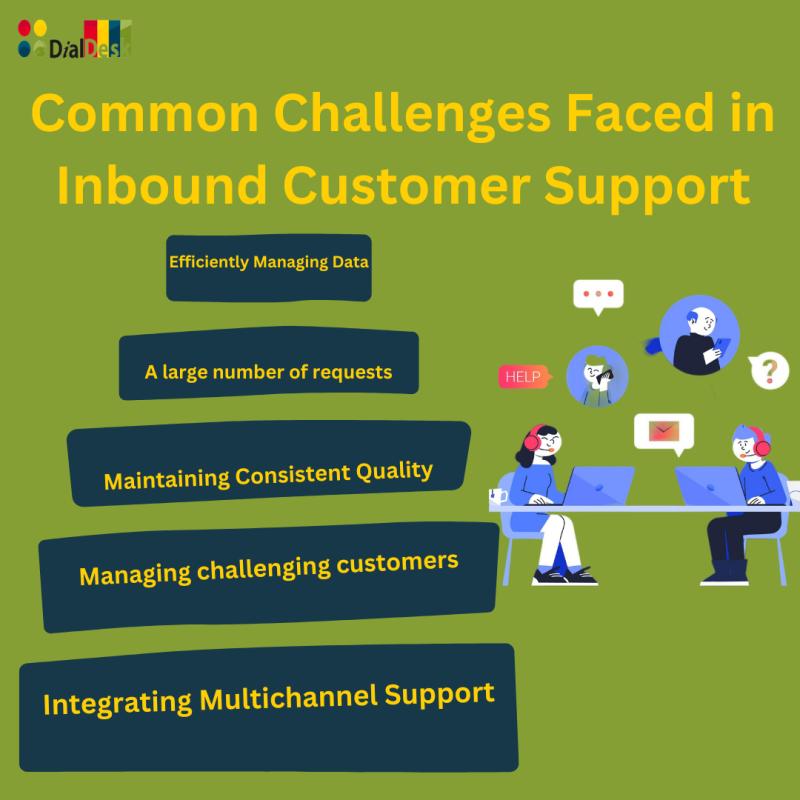Common Challenges Faced in Inbound Customer Support

A vital component of preserving a positive customer-business connection is inbound customer assistance. Despite being crucial for retaining and satisfying customers, handling incoming assistance can provide a number of difficulties. This article will examine some of the most typical challenges encountered by inbound customer service teams and provide advice on how to overcome them.
1. A large number of requests
Challenge: The Most frequent issue is , Handling a large number of incoming requests. Peak periods might see a sharp increase in customer enquiries and doubts, which can overburden support workers and result in long waiting hours for customers.
Solution: Prioritising and organizing requests can be aided by putting in place strong customer relationship management (CRM) solutions. Moreover , Automated solutions like chatbots and IVR systems can handle simple questions, allowing human agents to focus on more complex issues.. Adequate personnel during peak periods can also be ensured through effective scheduling and labour management.
ARE YOU AWARE OF ?
60% of customers say waiting on hold is the most frustrating part of the customer service experience [Source: Zendesk].
2. Maintaining Consistent Quality
Challenge: It's critical to maintain a consistent level of quality in customer support conversations. Responses that are inconsistent might drive away customers and damage the company's brand.
Solution : Frequent Training Programs: To guarantee that support agents are knowledgeable about the most recent protocols and industry best practices, offer them ongoing training and development opportunities.
Implement quality assurance (QA) programs to find areas for improvement and make sure that quality standards are being followed. These programs should include frequent call monitoring, feedback sessions, and performance reviews.
3. Managing challenging customers
Challenge: Difficult or furious customers are a common sight for customer service representatives. It might be difficult to handle these conversations sympathetically and professionally while finding a solution.
Solution: Providing agents with training in soft skills like empathy, active listening, and conflict resolution can help them deal with challenging clients more skilfully. Handling challenging contacts can also be facilitated by giving agents access to supervisors and a clear line of escalation for complex issues. Fostering a helpful workplace culture can lessen agent stress and enhance productivity.
4. Integrating Multi Channel Support
Problem: Customers want assistance via phone, email, chat, and social media, among other channels. It can be difficult to effectively manage various channels and provide a uniform consumer experience throughout.
Solution: The use of omnichannel support platforms can combine various kinds of contact into a single interface, which makes it easier for agents to monitor and handle conversations. A cohesive customer experience can be ensured by maintaining uniform training and practices across all channels. The omnichannel approach must be reviewed and updated frequently to accommodate shifting consumer preferences.
5. Efficiently Managing Data
Challenge: It's critical to handle massive amounts of client data effectively and securely. Ineffective data management can result in lost information, privacy problems, and inefficiencies.
Solution: It's critical to make investments in reliable data management solutions that guarantee data protection and adherence to laws like the GDPR. Data integrity can be preserved with the use of routine audits and modifications to data management procedures. Preventing data-related problems can also be achieved by teaching agents best techniques for handling data.
Did you know that
customers who use multiple channels to interact with a business spend 30% more than those who use only one channel [Source: Harvard Business Review]
6. Ensuring Agent Retention
Challenge: One of the biggest issues that customer support personnel may have is high turnover. Inconsistent client experiences can result from frequent turnover, which also disturbs team dynamics.
Solution: Keeping agents happy and providing them with chances for professional and personal growth might help keep them on staff. Providing competitive pay and benefits packages, as well as initiatives for acknowledgement and rewards, can help increase employee retention and job satisfaction. It is possible to fix workplace problems and boost morale by routinely asking for and acting upon agent feedback.
7. Balancing Speed and Quality
Challenge: Customers want their issues resolved quickly, but hurrying might result in errors and poorer assistance.
Solution: Agents can balance quality and speed by putting in place explicit criteria for response and resolution times. Efficiency and customer satisfaction can be raised by promoting a first contact resolution (FCR) focus. Performance indicators and customer comments can be regularly evaluated to identify areas for improvement and ensure that quality and speed are maintained.
9. Personalizing Customer Interactions
Challenge: Customers want individualized service that takes into account their particular preferences and past experiences. Giving this kind of individualized attention might be difficult, particularly for big businesses with sizable clientele.
Solution: By tracking client interactions and preferences through CRM systems, more individualized help may be provided
10. Measuring and Analyzing Performance
Challenge: Because there are so many measures and variables to consider, measuring and analysing customer support team performance can be difficult.
Solution: A thorough performance management system that monitors key performance indicators (KPIs) including customer happiness, FCR, reaction time, and resolution time can yield insightful data. The total performance of assistance can be improved by routinely analyzing this data and applying it to drive initiatives for continuous improvement. Fostering a culture of data-driven decision-making can assist in coordinating support activities with corporate goals.
Conclusion
Effective management of the complex issue of incoming customer support necessitates a systematic strategy. Organizations can improve customer satisfaction and loyalty by improving their support operations through an understanding of and response to the common difficulties mentioned above. Inbound customer solution assistance may be turned from a difficult chore into a competitive advantage by making the appropriate investments in equipment, training, and procedures, as well as creating a positive work atmosphere.
Post Your Ad Here
Comments